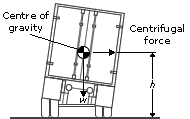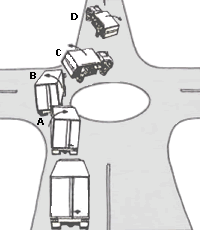An introduction programme for drivers of heavy motor vehicles.

There are many factors that influence a vehicle's tendency to roll over, but the following are the most crucial:

If all these factors are contained within acceptable levels, the vehicle will remain stable. If they are not, then the risk of loss of control and rollover will increase.
Typically rollovers occur during cornering (at either high or low speed) and during sudden evasive steering manoeuvres.
The following is an example of how rollover can occur at a roundabout, even though the truck may be proceeding straight through.

The driver of a loaded truck intends to proceed straight through a roundabout. They safely negotiate the left-hand bend at point ‘A’ and the vehicle rolls to the right. The driver then swings the steering to the right at ‘B’ to travel around the roundabout and the vehicle rolls to the left. But this time it rolls much further than it did at point ‘A’ because the directional changes of the vehicle match its roll resonance. At this point the load might even shift, transferring more weight to the left-hand side of the vehicle, increasing the roll still further and possibly overturning the vehicle on to its left side at point ‘C’ as shown. However, if the vehicle is able to continue past point ‘C’ and the driver then steers to the left, the vehicle will roll back to the right still more violently and is even more likely to overturn, this time on to its right side at point ‘D’.
This can occur at a surprisingly low speed, speeds which may be quite safe for another type of truck, even when fully laden. This danger is not restricted to roundabouts; S-bends and violent lane changes can present a similar hazard.
Drivers operating heavy vehicles need to make constant steering corrections, whether to compensate for simple road undulations and the effects of camber or wind, or when negotiating intersections and undertaking evasive manoeuvres to avoid other vehicles or obstacles.
These manoeuvres can be at relatively low speed but involve several directional changes (as in a roundabout) or take place at high speed, as in a steering correction during cornering. In each of these situations there is transfer of weight from one side of the vehicle to the other.